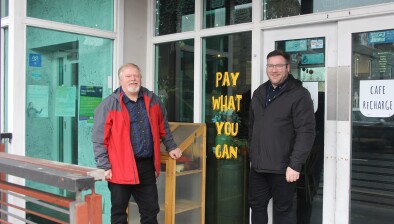MSPs visit Scottish Borders Housing Association renovation project

MSPs Christine Grahame and Paul Wheelhouse paid a visit to a Scottish Borders Housing Association (SBHA) project in Skirling which is helping to improve the energy-efficiency of some post-war houses.
The four houses have timber cladding and had a very poor energy-efficiency rating, making them difficult to keep warm. The work involves replacing existing cladding and applying wall insulation to ensure that heat is retained. The project also includes a further five houses in Broughton, Romanno Bridge, Eddleston and Manor Valley.
SBHA is working with contractors James Swinton and Co., which provided some photographs and example construction materials to assist in highlighting how the works have progressed, as well as the challenges faced.
SBHA home investment co-ordinator, Drew Moore, said: “The most efficient and cost effective heating for tenants is Gas Central Heating from an A Rated Combination Boiler system. However, SBHA has 410 rural properties that are ‘Off Gas’, which means that they cannot be connected to a mains gas supply.
“With these properties, all other EESSH measures require to be fully maximised to obtain EESSH compliance and make the properties as efficient and cost effective to run as possible. These measures include wall insulation – either cavity, internal or external; underfloor insulation; loft or room in the roof insulation; double glazing and insulated front and back doors as appropriate to the property.
“This project has been a challenge as the houses are in a rural area and off-grid, but the work will make a real difference to the Tenants living in them, particularly when the weather gets colder.”
Ms Grahame and Mr Wheelhouse were given the opportunity to visit a house which had been completed, as well as one in which work was taking place, and one in which the work was yet to start. This enabled them to see the difference that the work is making. They were also able to talk to tenants about the work.
Ms Grahame said: “It was good to meet two of the tenants who are obviously delighted with the upgrade especially as it will make their homes substantially better insulated and help with those ever increasing energy bills.
“It was also good to see local firms employed in these renovations.”
Mr Wheelhouse added: “I was very impressed by the upgrade in energy efficiency that SBHA is making to these houses, in light of the importance of enabling energy efficiency to help people manage rising energy costs and, ideally, reduce their energy use. However, it was also excellent to see investment in the strengthening the structural integrity of the properties, which were not originally intended to be here permanently, and in reducing noise pollution. It was clear from the discussions with the tenants, who have already had the improvements, that they were absolutely seeing the benefits from it.
“Some of the tenants raised other issues with us while we were there, which we are taking forward, and I have to thank Julia and her team for the approach they took to those points raised. That was really positive to see and showed a real commitment from Julia and SBHA to improve the wellbeing of their tenants.”
SBHA CEO Julia Mulloy said: “We were delighted to welcome Christine and Paul to Skirling to view the work being done there. SBHA tenants have told us that affordable warmth is important to them, and so improving the energy-efficiency of all homes is a key priority for the SBHA team.
“While this is a small project, it raises a number of important issues around affordable warmth in rural areas, and once complete the work will make a big difference to the lives of people living in these post-war timber homes.”









